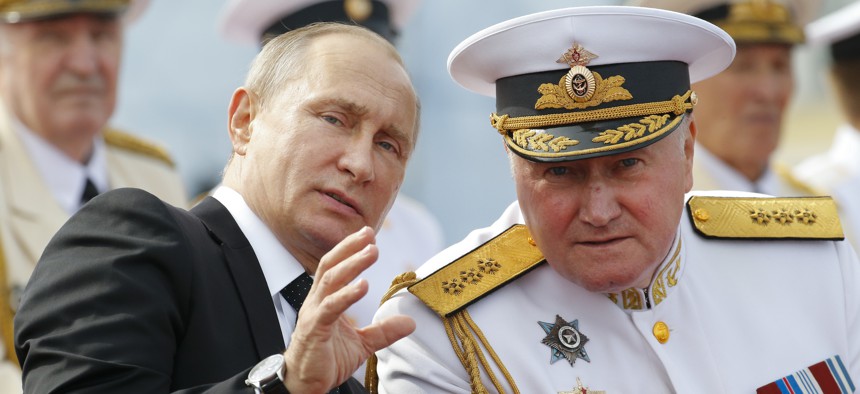
Russian President Vladimir Putin, left, chats with Commander-in-Chief of the Russian Navy Admiral Vladimir Korolev as they attend the military parade during the Navy Day celebration in St.Petersburg, Russia, on Sunday, July 30, 2017. AP Photo/Alexander Zemlianichenko
US and Russia Regard Each Other Warily in the Baltic and Black Seas
An uptick in Russian naval activity and U.S. freedom-of-navigation ops mean more tension in 2019.
2019 could be a tense year in the waters of the Baltic and Black Seas between the U.S. and Russia, as demonstrated by an uptick of Russian naval activity in both regions. At the same time, Ukraine is reaching out more than ever to the United States or help, leaving Washington in the position of figuring out how to manage the needs of an ally under attack against the peril of escalating conflict.
On Sunday, Russia “scrambled” a pair of warships to tail the U.S. destroyers Porter and Gravely in the Baltic Sea, Russian media outlet TASS reported. On Tuesday, the Russians simulated missile attacks on “sea targets,” a test of the targeting systems of the BAL coastal missiles deployed to the Baltic oblast of Kaliningrad, reported TASS.
A thousand miles to the southeast, Russia recently deployed a BAL to the illegally annexed Black Sea peninsula of Crimea, and staged additional exercises there in December. This week, the U.S. destroyer Donald Cook arrived in the Sea to replace the dock landing ship Fort McHenry. “The U.S. Navy routinely operates in the Black Sea consistent with the Montreux Convention” — the treaty governing the Black Sea —“and international law. We expect other actors operating in the region to obey international law and avoid behaviors that would be considered unsafe or escalatory in nature,” Pentagon spokesperson Eric Pahon said.
The U.S. naval moves take place after a major uptick in hostilities between Ukraine and Russia in the nearby Sea of Azov, connected to the Black Sea via the narrow Kerch Strait. In November, Russian forces seized Ukrainian vessels and sailors there in an attack Ukraine says was premeditated.
Chatter in the region is up. “There’s been a lot of interesting Russian radio activity in the Southern military district…radio listeners reported multiple brigade and division chatter started yesterday evening. Possible readiness [exercise] coming up?” said Aki Heikkinen, curator of the site Russianmilitarywatch.com.
If tensions continue to rise, history suggests that U.S. forces should prepare for an increase in electronic warfare, or EW, attacks.
During the Azov Sea crisis, “Russian military units attacked Ukrainian ships with sophisticated EW methods,” Adm. Ihor Voronchenko, the commander of the Ukrainian Navy, told Defense One in December. Speaking through an interpreter, Voronchenko said the Russians disrupted the Iridium satellite communication system that Ukraine uses and spoofed GPS signals in the region.
During Voronchenko’s visit to the United States he said, he met with U.S. Navy CNO Adm. John Richardson and other officials at the departments of Defense and State. The Ukrainian admiral asked for help acquiring Island-class and Mark VI patrol boats and various electronic sensors in 2018 to 2025. The State Department soon after asked Congress for an additional $10 million for the Ukrainian navy. Lawmakers have yet to take up the request.
It’s one of several signs of a growing partnership. Since 2014, the United States has given Ukraine aid worth over $1 billion. Some $42 million of that came through the Global Security Contingency Fund, or GSCF — a pot of money largely funded by Defense but administered jointly by the Defense Department and State to better spread it across foreign government agencies. State officials say the money is helping Ukraine build up its National Guard, stand up its special operations forces teams, and advance toward interoperability with NATO.
“You can see a lot of impact on the ground” an official affiliated with the program said. The official said that training and funds were helping more Ukrainian troops survive clashes with Russian-backed forces in Eastern Ukraine. “Survivability is up. Folks are coming back,” said the official.
The official said there’s one more that the U.S. government can do, and at relatively low cost, to help in the fightl: allow more foreign military sales to Ukraine.




